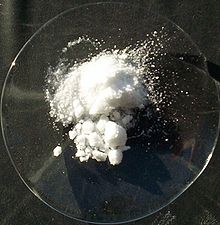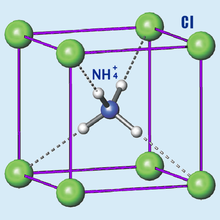This is an old revision of this page, as edited by Beetstra (talk | contribs) at 13:50, 15 February 2012 (Saving copy of the {{chembox}} taken from revid 476333817 of page Ammonium_chloride for the Chem/Drugbox validation project (updated: 'ChEMBL').). The present address (URL) is a permanent link to this revision, which may differ significantly from the current revision.
Revision as of 13:50, 15 February 2012 by Beetstra (talk | contribs) (Saving copy of the {{chembox}} taken from revid 476333817 of page Ammonium_chloride for the Chem/Drugbox validation project (updated: 'ChEMBL').)(diff) ← Previous revision | Latest revision (diff) | Newer revision → (diff)| This page contains a copy of the infobox ({{chembox}}) taken from revid 476333817 of page Ammonium_chloride with values updated to verified values. |
 | ||||
 | ||||
| Names | ||||
|---|---|---|---|---|
| IUPAC name Ammonium chloride | ||||
| Other names Sal ammoniac, salmiac, nushadir salt, sal armagnac, salt armoniack | ||||
| Identifiers | ||||
| CAS Number | ||||
| 3D model (JSmol) | ||||
| ChEBI | ||||
| ChemSpider | ||||
| EC Number |
| |||
| KEGG | ||||
| RTECS number |
| |||
| UNII | ||||
InChI
| ||||
SMILES
| ||||
| Properties | ||||
| Chemical formula | NH4Cl | |||
| Molar mass | 53.491 g/mol | |||
| Appearance | White solid hygroscopic | |||
| Odor | odorless | |||
| Density | 1.5274 g/cm | |||
| Melting point | 338 °C (decomposes) | |||
| Solubility in water | 297 g/L (0 °C) 372 g/L (20 °C) 773 g/L (100 °C) | |||
| Solubility in alcohol | 6 g/L (19 °C) | |||
| Acidity (pKa) | 9.245 | |||
| Refractive index (nD) | 1.642 | |||
| Thermochemistry | ||||
| Std molar entropy (S298) |
94.85 J K mol | |||
| Std enthalpy of formation (ΔfH298) |
−314.55 kJ/mol | |||
| Hazards | ||||
| GHS labelling: | ||||
| Pictograms | class="wikitable collapsible" style="min-width: 50em;" | |||
| Pictogram | Code | Symbol description | Image link | |
 |
GHS01 | {{GHS exploding bomb}} | Image:GHS-pictogram-explos.svg | Explosive |
 |
GHS02 | {{GHS flame}} | Image:GHS-pictogram-flamme.svg | |
 |
GHS03 | {{GHS flame over circle}} | Image:GHS-pictogram-rondflam.svg | |
 |
GHS04 | {{GHS gas cylinder}} | Image:GHS-pictogram-bottle.svg | |
 |
GHS05 | {{GHS corrosion}} | Image:GHS-pictogram-acid.svg | Corrosive |
 |
GHS06 | {{GHS skull and crossbones}} | Image:GHS-pictogram-skull.svg | Accute Toxic |
 |
GHS07 | {{GHS exclamation mark}} | Image:GHS-pictogram-exclam.svg | Irritant |
 |
GHS08 | {{GHS health hazard}} | Image:GHS-pictogram-silhouette.svg | Health Hazard |
 |
GHS09 | {{GHS environment}} | Image:GHS-pictogram-pollu.svg | Environment |
See also
- {{H-phrases}}
- {{P-phrases}}
- Category:GHS templates
|-
|-
| style="padding-left:1em;" |
Hazard statements| H302, H319
|-
|-
| style="padding-left:1em;" |
Precautionary statements| P305+P351+P338
|- | NFPA 704 (fire diamond)
|

|- | Flash point | Non-flammable
|-
| colspan=2 style="text-align:left; background-color:#eaeaea;" | Lethal dose or concentration (LD, LC): |-
|-
| style="padding-left:1em;" |
LD50 (median dose)| 1650 mg/kg, oral (rat)
|-
|-
! colspan=2 style="background: #f8eaba; text-align: center;" |Related compounds
|-
|
Other anions| Ammonium fluoride
Ammonium bromide
Ammonium iodide
|-
|
Other cations| Sodium chloride
Potassium chloride
Hydroxylammonium chloride
|-
| colspan=2 style="text-align:left; background:#f8eaba; border:1px solid #a2a9b1;" |
Except where otherwise noted, data are given for materials in their standard state (at 25 °C , 100 kPa).|-
|}
Chemical compound- ^ Solid state data from Ammonium chloride in Linstrom, Peter J.; Mallard, William G. (eds.); NIST Chemistry WebBook, NIST Standard Reference Database Number 69, National Institute of Standards and Technology, Gaithersburg (MD) (retrieved 2008-10-22)
- "Globally Harmonized System of Classification and Labelling of Chemicals" (pdf). 2021. Annex 3: Codification of Statements and Pictograms (pp 268–385).
- ^ Template:SigmaLink